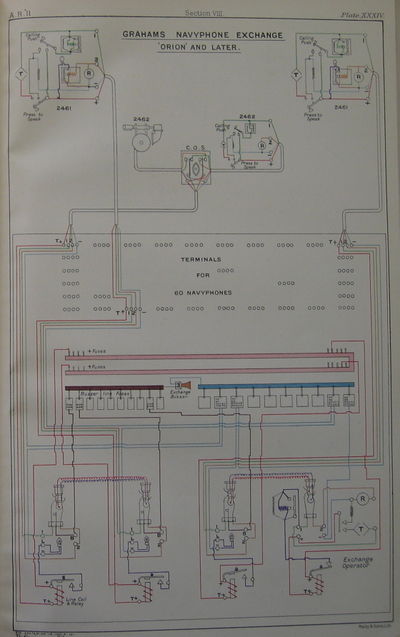Graham Navyphone Exchange

As first deployed in Orion. On the lower left is a detailed view of 2 remote navyphones on a call, and the lower right shows the local operator element connected to a remote station.
The Graham Navyphone Exchange was a switchboard for allowing those navyphones not directly wired to others on the ship to be flexibly interconnected in whatever manner the callers demanded. A version of it was under trial at Vernon in 1906[2] and it is described in the Annual Report of the Torpedo School, 1911 as being first installed in Orion, and it was forecast that it would see service in future ships.
The switchboard could support up to 60 remote navyphones, representing each by an indicator lamp next to a stereo-type plug socket. The operator was equipped with his own transmitter/receiver pair and a supply of plug cables, each with a cross-over for the short and long prong contacts.
Testing in 1906
The first units were tested in Vernon and Dreadnought (not for fire control purposes) in 1906. A call to the exchange caused a bell to ring and a ruby lamp next to the calling phone's socket to illuminate. The operator would place his exchange plug into the socket and be able to speak to the caller, simultaneously switching the remote phone off from again ringing the exchange bell. Remote stations were bridged together by plugging the cable for either one into the socket for the other, causing a white lamp to glow. When this lamp went out (presumably, due to one party hanging up), the operator would remove the plug.[3]
Patching a Call Through, 1911
A single local buzzer and a indicating lamp next to each socket alerted operators when a navyphone connected to the exchange wanted to place a call. The operator then plugged his cord into the caller's extension socket and pressed a switch and verbally asked whom the caller wishes to speak to. The act of plugging in in this manner broke the buzzer circuit but kept the caller's indicating lamp on.
The operator, upon understanding which station he should connect the caller to removes his end of the plug from his element, and plugs it to the socket of the requested navyphone. The cable performs a cross-over to connect the transmitter of one end to the receiver of the other and vice-versa. It is not clear to me whether the insertion of the plug into the second station's socket makes the called navyphone ring, but I believe the caller must actually still press his call-up button to make the called station ring.
The exchange was created for the then-current Pattern 246X Navyphones, which generally had push-to-talk buttons. When a user was talking, his station's lamp would glow. It was incumbent upon the operator to notice two long-dark lamps with a patch cord between them and then remove the patch cord to terminate the connection.
The operator could connect his own element to that of any of the 60 sockets. This would cause the buzzer to sound until he pressed his press-while-speaking. I think this would cause his voice to simply spill forth, intercom-like from the remote navyphone. In opposite manner, any navyphone wired to the exchange could press-to-talk and speak directly through the buzzer circuit to the operator, without calling up.
See Also
Footnotes
Bibliography
- H.M.S. Vernon. Annual Report of the Torpedo School, 1906, with Appendix (Wireless Telegraphy). Copy 46 at The National Archives. ADM 189/26.
- H.M.S. Vernon. Annual Report of the Torpedo School, 1911, with Appendix (Wireless Telegraphy). Copy 15 at The National Archives. ADM 189/31.